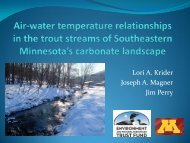Minnesota Water Resources Conference - Water Resources Center ...
Minnesota Water Resources Conference - Water Resources Center ...
Minnesota Water Resources Conference - Water Resources Center ...
Create successful ePaper yourself
Turn your PDF publications into a flip-book with our unique Google optimized e-Paper software.
Concurrent Sessions II 1:15–2:45<br />
Track B: Agricultural Drainage Impacts<br />
BOOK OF ABSTRACTS<br />
Tuesday, Monday, October 27 23<br />
Effect of Tillage and Nutrient Sources on Dissolved Organic Carbon Fluxes from Soil<br />
Holly Dolliver, University of Wisconsin-River Falls, holly.dolliver@uwrf.edu; Satish Gupta, University of <strong>Minnesota</strong><br />
Soils are a crucial component of global carbon cycling. The soil organic carbon pool is highly dynamic and<br />
strongly influenced by tillage and other management practices. Fluxes of dissolved organic carbon from the<br />
terrestrial environment can substantially impact aquatic chemistry and biology. The objective of this field study<br />
was to quantify the effects of tillage and nutrient sources on both fluxes and storage of soil organic carbon.<br />
Tillage treatments included chisel plow and no-tillage. These tillage treatments have been in operation since<br />
1993; however, the study was conducted from 2003 to 2007. The nutrient sources were two types of manure (hog<br />
and beef manure) and a synthetic fertilizer (urea). Both runoff and leachate were collected from 2003-2007. In<br />
addition, three soil cores to a depth of 120 cm were also taken from each plot to quantify soil carbon storage.<br />
Measuring and Modeling the Impacts of Shallow Subsurface Drainage in a Cold Climate<br />
Gary Sands, University of <strong>Minnesota</strong>, grsands@umn.edu; Wan Luo, University of <strong>Minnesota</strong>; Jeffery Strock, University of<br />
<strong>Minnesota</strong><br />
The hydrologic and water quality impacts of shallow subsurface drainage have been investigated for the<br />
previous seven years through field research at the University of <strong>Minnesota</strong> Southern Research and Outreach<br />
<strong>Center</strong> (south-central <strong>Minnesota</strong>). Seven-year pooled results from this study indicate that subsurface drains<br />
placed at 90cm discharge about 20 percent less water and nitrate compared to the more traditional drain depth<br />
of 120cm. A modeling study has been undertaken using the DRAINMOD NII model to investigate the influence<br />
of shallow drainage on drainage hydrology and water quality over a longer climatic record, additional soils<br />
types, and additional drain depths, than were previously studied in the field research. This paper will report on<br />
the progress of the modeling effort and will present the results of calibration and validation of the DRAINMOD<br />
NII model with data from the shallow drainage field experiment.<br />
Evaluating Field-Scale Agriculture Drainage and Best Management Practices on <strong>Water</strong> Quality<br />
Lucas Bistodeau, <strong>Minnesota</strong> State—Mankato, lucas.bistodeau@mnsu.edu; Shannon Fisher, <strong>Minnesota</strong> State—Mankato<br />
Past research with plot-scale studies has addressed agricultural nutrient losses; however, applying this<br />
knowledge to field-scale applications has proven to be difficult. By understanding nutrient and pesticide<br />
transfer mechanisms in a field-scale setting, we can formulate land management practices to reduce non-point<br />
source pollution to surface waters. Our objectives were to 1) evaluate agricultural nutrient practices (NO 3<br />
-N, TP<br />
and OP) to reduce non-point source pollution and 2) evaluate the effect that subsurface tile drainage spacing<br />
has on nutrient and acetochlor losses. Nutrient results from 2007 and 2008, in a paired watershed, showed 15.2<br />
and 24.3 meter spaced subsurface tiled systems using late fall, higher rate-applied anhydrous ammonia had<br />
higher nitrate-nitrogen flow-weighted mean concentrations (11.3 mg/L) than the BMP spring-applied urea<br />
fields (9.2 mg/L). Total phosphorus flow-weighted mean concentrations of variable rate applied P & K fields had<br />
a significant difference between BMP fields with concentrations of 0.14 mg/L and 0.05 mg/L. Quicker response<br />
time and higher peak flow values were observed in narrower tile spacing for both years.<br />
<strong>Minnesota</strong> <strong>Water</strong> <strong>Resources</strong> <strong>Conference</strong>, October 27–28, 20078 26
















